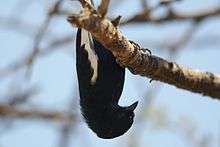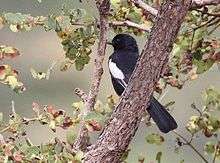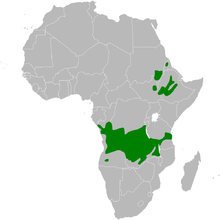White-winged black tit
The white-winged black tit (Melaniparus leucomelas) is a passerine bird in the tit family Paridae. It is also known as the white-winged tit, dark-eyed black tit or northern black tit.[2] The species was first described by Eduard Rüppell in 1840.
| White-winged black tit | |
|---|---|
 | |
| Nominate race in Ethiopia | |
 | |
| M. l. subsp. insignis in Angola | |
| Scientific classification | |
| Kingdom: | Animalia |
| Phylum: | Chordata |
| Class: | Aves |
| Order: | Passeriformes |
| Family: | Paridae |
| Genus: | Melaniparus |
| Species: | M. leucomelas |
| Binomial name | |
| Melaniparus leucomelas (Rüppell, 1840) | |
 | |
| Map showing ranges of two races, respectively north and south of equator | |
| Synonyms | |
| |
Description
It is mainly black with a white wing patch, but differs from the more northern white-shouldered tit (Melaniparus guineensis) with which it sometimes considered conspecific in that it has a dark eye.
Range and races
It is found in central Africa, from Angola in the west to Ethiopia in the east. There are two races:[3]
- M. l. subsp. leucomelas Rüppell, 1840 – Ethiopia, Eritrea, Sudan and South Sudan
- M. l. subsp. insignis Cabanis, 1880 – African equator to southern subtropics
Taxonomy
The white-winged black tit was formerly one of the many species in the genus Parus but was moved to Melaniparus after a molecular phylogenetic analysis published in 2013 showed that the members of the new genus formed a distinct clade.[4][5]
References
- BirdLife International (2013). "Parus leucomelas". IUCN Red List of Threatened Species. 2013. Retrieved 26 November 2013.CS1 maint: ref=harv (link)
- Gosler, A. & Clement, P. (2019). "Dark-eyed Black Tit (Melaniparus leucomelas)". In: del Hoyo, J., Elliott, A., Sargatal, J., Christie, D. A. & de Juana, E. (eds.). Handbook of the Birds of the World Alive. Lynx Edicions, Barcelona. Retrieved 26 November 2019.
- "White-winged Black Tit (Parus leucomelas) - HBW 12, p. 731". Internet Bird Collection. Retrieved 27 June 2016.
- Johansson, U.S.; Ekman, J.; Bowie, R.C.K.; Halvarsson, P.; Ohlson, J.I.; Price, T.D.; Ericson, P.G.P. (2013). "A complete multilocus species phylogeny of the tits and chickadees (Aves: Paridae)". Molecular Phylogenetics and Evolution. 69 (3): 852–860. doi:10.1016/j.ympev.2013.06.019. PMID 23831453.
- Gill, Frank; Donsker, David (eds.). "Waxwings and their allies, tits & penduline tits". World Bird List Version 6.1. International Ornithologists' Union. Retrieved 15 February 2016.
- Gill, Frank B.; Slikas, Beth; Sheldon, Frederick H. (2005). "Phylogeny of titmice (Paridae): II. Species relationships based on sequences of the mitochondrial cytochrome-b gene". Auk. 122 (1): 121–143. doi:10.1642/0004-8038(2005)122[0121:POTPIS]2.0.CO;2.
External links


- Sound recordings, xeno-canto
